Lateral marks are positioned at the sides of channels, which side of the channel the respective buoys are placed is determined by the Direction of Buoyage.
Direction
Generally the direction of buoyage runs clockwise around continents, it can be referenced in Admiralty Sailing Directions
Out at sea around the British Isles, the general direction of buoyage runs towards the north on the west coast and through the Irish Sea; to the east through the English Channel and north through the North Sea.
Closer in to land they are organised relative to the direction of entry to harbour. In areas where there is any doubt as to the direction of buoyage, it will be indicated by this symbol.

Direction of buoyage

Colour
Under the 'A' system, if you are heading in the direction of the arrow you will have green buoys to starboard and red buoys to port.
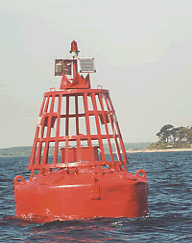 |
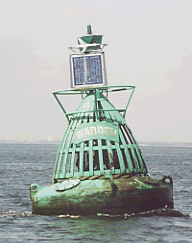 |
|
Port hand lateral mark. |
Starboard hand lateral mark. |
Chart Symbols
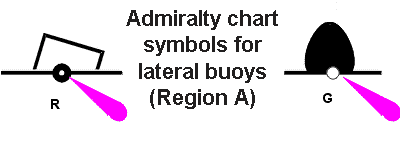
I.A.L.A. 'B'
I.A.L.A. 'A' is used for most of the World. The exceptions are, all of the Americas, the eastern Pacific, the Philippines, South Korea and Japan.
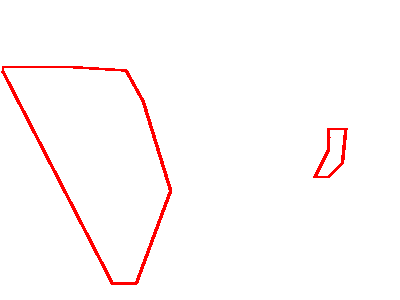
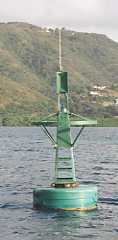 |
 |
|
Port hand lateral mark. |
Starboard hand lateral mark. |
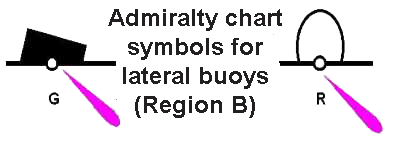
Shape
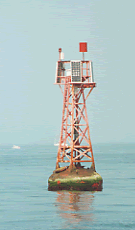 |
|
Port hand lateral pillar mark. |
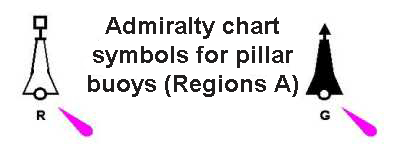
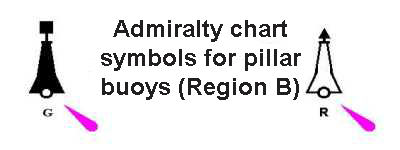
Topmark
If the buoy has a topmark, it will be the same shape at the buoy, conical for a starboard and square for a port hand buoy.
Numbering
Lights
Red buoys have red lights, and green buoys have green ones. There will be a variety of sequences from single flashes to groups such as Fl.(2).R.5s. Or a Red light, flashing twice in 5 seconds.
Preferred channel markers
Where a channel splits into a major and a minor channel, a preferred channel buoy may be used. These have both red and green colouring, but the main colour is that for the major channel, with the colouring for the minor channel being only a stripe.
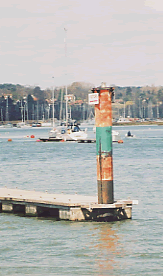 |
|
Preferred channel to starboard mark (leave the mark on the vessel's port side for the main channel). |
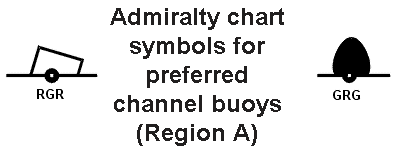
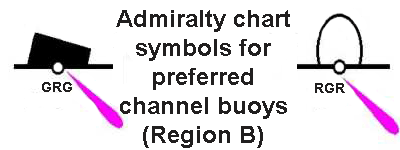
Lights
Preferred channel markers have a distinct light pattern. Fl(2+1). This means that there are 2 flashes, then a gap and then 1 flash, then a longer gap. This sequence can be difficult to identify; it is easy to assume that you are looking at two different buoys. The light colour will match the main colour of the buoy or beacon.
Buoyage in rivers
The buoyage in a river is usually the responsibility of the harbour master or yacht club. As a result, the system can be very individual!
Normally the buoys will be small, but also different things may be used. One creek on the east coast appears to be marked with old beer barrels.
|
A small unlit, starboard hand buoy near the entrance to the River Hamble. In this case it marks the edge of the shallow water for small craft, and is well outside the buoyage for the main channel. |
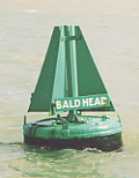 |
On the approach to major harbours it is common to find that there are a set of buoys for shipping and a set of smaller buoys in shallower water for small craft. It is useful to remember that most buoyage is established for larger vessels and even where there is no buoyage specifically for small craft, it may be prudent to approach the harbour just outside the main channel.
This approach gives the benefit of being able to follow the buoys in, but also avoids the problems of avoiding the ships.
If this is done, a thorough check should be made of the chart for any hazards outside the main channel. It is also useful to remember that if a ship passes you when you are in shallow water, the suction of the ship's propellers may cause a considerable reduction in water depth. When canoeing in Southampton Water, I have seen 3 to 4 feet of water disappear in seconds when a large ship passed through!
Sailtrain.co.uk is free to use, but if you feel you would like to contribute to the running and development costs you can donate via Paypal:
Additional Resources:

